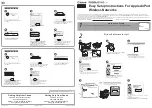
radiate radio frequency energy and, if not installed and used in accordance with the
manufacturer’s instructions, may cause interference harmful to radio communications.
If this equipment does cause interference, which can be determined by turning the
equipment off and on, the user is encouraged to try to correct the interference by one or
more of the following measures:
•
Reorient or relocate the receiving antenna.
•
Increase the separation between the equipment and receiver.
•
Connect the equipment to an outlet on a circuit different from that to which the receiver
is connected.
•
Consult the dealer or an experienced radio or TV technician for help.
RF Radiation Exposure Statement:
This equipment complies with FCC RF radiation
exposure limits. This equipment should be installed and operated with a minimum
distance of 20 cm between the radiator and your body for 2.4-GHz and 5-GHz operations.
This transmitter must not be co-located or operating in conjunction with any other antenna
or transmitter. When operated in the 5.15 to 5.25-GHz frequency range, this device is
restricted to indoor use to reduce the potential for harmful interference with co-channel
mobile satellite systems.
Complies with the Class B limits for radio noise emissions as set out in the
interference-causing equipment standard entitled “Digital Apparatus,” ICES-003 of
Industry Canada.
Cet apareil numerique de la classe B respecte toutes les exigencies du Reglement sur le
materiel brouilleur du Canada.
Radio Safety Standards
•
FCC CFR 47, Part 2 Frequency allocations and general treaty matters, General rules
•
FCC CFR 47, Part 15 Radio Frequency Devices
•
EN 300 328 EMC and Radio Spectrum Matters 2.4-GHz ISM band
•
EN 301 489-1 EMC and Radio Spectrum Matters: Common Technical requirements
•
EN 301 489-17 EMC and Radio Spectrum Matters: 2.4-GHz wideband and 5-GHz RLAN
•
EN 301 893 Broadband Radio Access Networks 5-GHz RLAN
•
RTTE Directive 1995/5/EC
•
Various Country Specific Radio Regulations (see Country List in
Regulatory Guide
)
WARNING:
In the USA, install the access point and any externally attached
antennae a minimum of 7.9 in. (20 cm) away from people. This safety warning
conforms with FCC radio frequency exposure limits for dipole antennae such
as those used in the access point.
39
Copyright © 2012, Juniper Networks, Inc.
Chapter 6: Certifications for the Access Point
Summary of Contents for WLA Series
Page 8: ...Copyright 2012 Juniper Networks Inc viii WLA532E Access Point Hardware Documentation ...
Page 12: ...Copyright 2012 Juniper Networks Inc xii WLA532E Access Point Hardware Documentation ...
Page 14: ...Copyright 2012 Juniper Networks Inc 2 WLA532E Access Point Hardware Documentation ...
Page 26: ...Copyright 2012 Juniper Networks Inc 14 WLA532E Access Point Hardware Documentation ...
Page 32: ...Copyright 2012 Juniper Networks Inc 20 WLA532E Access Point Hardware Documentation ...
Page 34: ...Copyright 2012 Juniper Networks Inc 22 WLA532E Access Point Hardware Documentation ...
Page 40: ...Copyright 2012 Juniper Networks Inc 28 WLA532E Access Point Hardware Documentation ...
Page 42: ...Copyright 2012 Juniper Networks Inc 30 WLA532E Access Point Hardware Documentation ...
Page 46: ...Copyright 2012 Juniper Networks Inc 34 WLA532E Access Point Hardware Documentation ...
Page 54: ...Copyright 2012 Juniper Networks Inc 42 WLA532E Access Point Hardware Documentation ...
Page 90: ...Copyright 2012 Juniper Networks Inc 78 WLA532E Access Point Hardware Documentation ...
Page 92: ...Copyright 2012 Juniper Networks Inc 80 WLA532E Access Point Hardware Documentation ...
















































